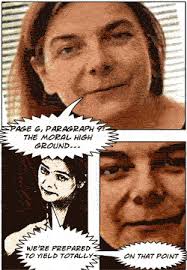More and more members are beginning to feel that the gap between dedicated campus campaigning and full-time union professionalism has become too vast! AU is a vertical union representing casualised researchers and teaching staff as well as “permanent” lecturers and professors. AU was formed by the 2006 merger of the rather lame-duck Association of University Teachers (AUT) and the somewhat more bolshie National Association of Teachers in F/HE (NATFHE). That merger was itself something of a conjuring act and the organisation which emerged from it has not yet come to terms with the political and social rift in its composition.

The formidable, self-driven Hally Sunt was elected General Secretary of the union in 2007. She has firmly consolidated her grip on power and has so far beaten off all opposition by a combination of shrew political maneuvering and a capacity to exploit the cleavages between the varying shades of “leftism” which render AU largely impotent as a political force. Faced with lukewarm “old” and campaigning “new” Left, what AU have finally ended up with is a grandiose Hally…..The General Secretary, with all her quirks, has shrewdly emasculated her Executive to personally become the union!

AU is politically divided between the somewhat larger “broad left” whose members are mainly part of the old AUT and the harder “left” or “real left”, the more politically radical whose membership trace largely back to NATFE. The result is an operational lock-jaw which prevents the union from making a solid impact in its negotiations with university and college management.

There can be no question that the work of the union is vital and that much professional and voluntary work is excellent. Apart from day to day branch case-work, AU is noted for its opposition to privatization of education, stopping academic casualisation, including the use of temporary contracts and campaigning for equality. None of these objectives have achieved much in recent years and the feeling among the rank and file is that the polite middle-class slant of AU crusading is something of a damp squid. Confronting AU demands at campus level is as exciting as being mauled by a toothless sheep.
In all of these areas AU have been attracting increasing dissatisfaction, reflected in a fall in membership and apathy among members. First AU`s track-record for case-work has been denigrated by the failure of so many of the cases it has taken to tribunal. Casual members, who now represent a growing proportion of the total membership, feel disenchanted with the elitist attitude of the union Executive.
The same unhappy sentiments are expressed by retired member’s branches. Effectively the union has abandoned them because with their reduced-rate subscriptions making up such a modest share of the union’s coffers, AU senior managers frankly believe casualized or retired members hardly deserve a voice! Indeed AU have been studiously trying to undermine its own Anti-Casualization Committee, one of the few genuinely critical voices at the heart of the union’s coal-face struggle. This has created an increasing unity between casualized and retired members which cuts across their ideological leanings. Ironically, it is among these poorest unionists, many with no proper job, that the most sterling sacrifices in time and effort have been made.
Other union campaigners have also been shafted. On intra-union equality, the union’s black members have demonstrated against the union’s apparent docility on issues affecting black comrades. It is striking that in recent years AU have yet to champion a single grievance raised by an ethnic minority despite overt problems in the university and college sectors. Moreover since 2007, AU has been embroiled in controversy for its policy of boycotting Israeli academia. Some Jewish members resigned following claims of underlying institutional anti-Semitism. The union which “self-promotes” preoccupation with equality seems less equal than one might hope!
In July 2011, AU was notified of a Jewish member’s intention to sue under the Equality Act with the Employment Tribunal in September 2011 and was heard in the Summer of 2012. While the complaint was rejected this experience severely damaged AU`s reputation. The union’s own Equality Chief, Helena Cardigan, has frequently been criticized for lack of teeth, apathy with bread and butter equality issues, and being out of touch with the maelstrom of college equality challenges.
When under pressure AU’s stage response is to draft a new booklet- at a time when members desperately want action. Faced with a mounting catastrophe in both the Higher and Further Education sectors, the typical AU solution is to do a new “stress survey” beautifully compiled with a staff of dozens, and all from their five-star, politically correct offices in north central London!
The union has also been criticized for its reliance on e-surveys when determining policy such as in the General Secretary’s proposal to Congress in 2012 that the size of the National Executive Committee be reduced from 70 members to a maximum of 40, to save money. E-surveys were vehemently challenged at Annual AU Congress on the grounds that they ‘encourage people to vote without hearing the debates first’. But of course all Hally has cared about is carrying the vote, and so if e-democracy gets another victory for Hally, then more e-democracy AU shall certainly have! “To h..l” with the pseudo-democracy of Union Congress!
AU’s reputation has also suffered from a sense of being isolated financially and professionally from the majority of its members who are now casualized academic and academic-related staff. With the General Secretary on a salary and benefits package worth a rough but impressive total of £126,982, and the average salary and benefits of AU’s senior management team at about £105,000 (levels now well in excess of even the professoriate of the UK’s most prestigious universities) there is alarm at AU’s salary bill.
Things are a great deal better in the working benefits of AU staff than in the members the union serves. With many HQ staff saving their personal money by largely working from home, there is also increasing dissatisfaction that the range of perks, and the astonishing professional average salary for an AU official (£61,000) is also well in excess of the wages of the vast majority of the members it represents. AU is committed to a policy of merging the former NATFE staff with the higher AUT pay scales so that the only way for the salary bill to go is up. The future trend is a union with a vastly paid and benefit-pampered staff and a membership living on zero-hours contracts and college agency hours!
Recently facing an unprecedented financial crisis when its bank refused to allow any further borrowing without drastic restructuring, AU took action. However there was membership anger at a pay-off which led to a drop in staff compliment of just 5, but cost almost £1 million, and allegedly a single pay-off to a senior manager cost £350,000 and included his immediate re-employment at the same grade. This seems to be an utter moral contradiction of everything a trade union should stand for.
AU had previously been hammered for its decision to acquire new showcase premises in Camden Town when it took over a decade for the union to sell its old NATFE HQ in Britannia Street. When that building was eventually sold, just recently, after costing the union more than a half-million annually in security and up-keep, the sale was at a massive loss. This is professional financial mismanagement on a colossal scale! It is hard to conceive how the Executive could have allowed this mess to continue with only the most paltry and feeble criticisms.

By stark comparison, long-standing branch members are increasingly angry that AU union bosses now lack the financial resources to represent members legally and that the union has fallen into disrepute because of its lax financial protocols. Many feel their subs have gone into fat union pay-packets. To grassroots members it seems that the gulf between the professional union officials and the vast bulk of lecturers and researchers has got so vast, that AU have lost all moral authority. Moreover with Ms Sunt and some of her immediate senior management team facing accusations of bullying, many members are of the view that they have no-where to turn.

There can be no question that from the moment of achieving power, Ms Sunt identified key staff as her “enforcers” of policy, but with AU losing out to the employers so consistently time after time in recent years, it seems that many members want to call time on Hally’s tenure. Heavily reliant on the “enforcement skills” of her secretive organizational mandarin, Saul Pottrell, many members have begun to question whether they have a union democracy or a Sunt dictatorship. For many stalwart unionists, Hally has long ago yielded totally and lost the moral high ground! But as a sometime club bouncer General Secretary Sunt is quite able to muscle her way through a decidedly luke-warm academic opposition.
Many ordinary AU members, especially those on the radical left wish to see a more proletarian union grounded in the genuine democracy of members. The elevation of a previous GS to the Lords (Baron Ties-man) is seen by many of the grassroots as symptomatic of a union which has no credibility and which is little more than a political platform for its senior professionals. As AU’s supposed heavyweight, many rank and file feel Hally has yielded totally to the employers, has lost the moral high ground, and the only place where she throws her weight around is with her own staff and the membership!
That approximately 86% of the union’s average budget now goes on salary and physical plant, and a mere ballpark 9% on membership defense and campaigning is viewed as a national disgrace. Finally, renewed accusations of bullying and intimidation of members by the senior management team, and the expulsion of outspoken dissident members, points to a union in crisis, and which ill equips its membership for the long fight against university and college employers.
ADVISORY: This is a work of humorous fiction and any similarities with persons or places real or imagined is purely a matter of coincidence. If you’ve been bullied or are unhappy with your union at any F/HE institution don’t hesitate in confidence to E-MAIL: bullied.academics@yahoo.co.uk Victims may complain without penalty under their college procedures or consider making a complaint to their local police. Where the police are contacted bullying usually ceases immediately.
1 comment:
the main academic union has some comparisons with the banking system
top union officials earn far more than even the most senior academics
the lowliest union official earns far more than any full-time lecturer
with 2 excellent premises at merger, this union managed to lose money on both and spend a mint on a new headquarters which is not even fit for purpose
executive leadership?
Post a Comment